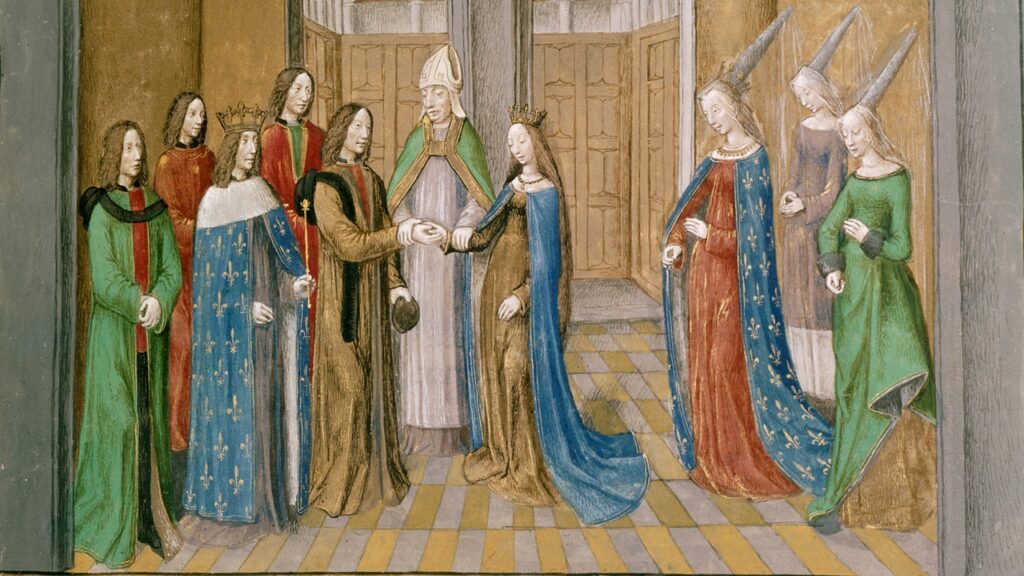The lives and experiences of women in the tumultuous Middle Ages were often shrouded under a veil of complexity. From the hearth and home to the church and beyond, women navigated a world that presented both challenges and opportunities.
Though harsh, those lives were also hopeful. Let’s journey through their adversities and constraints as well as their resilience and the pockets of agency they found within or despite these bounds.

Middle Ages: The Backdrop
The Middle Ages, spanning from the 5th to the late 15th century, was a period that witnessed the ebb and flow of civilizations across a vast region stretching from the furthest reaches of Europe to parts of what is now known as North America.
Also referred to as the Medieval Era, it was marked by the fall of the Western Roman Empire leading up to the Renaissance. That point in history encompassed many countries, including the diverse kingdoms and territories of Europe, the Byzantine Empire, and regions that would later form part of North America through Viking exploration and settlement.
Within this historical context, the lives of women unfolded under the weight of societal structures deeply influenced by the feudal system, the Church, and emerging urban centers.
As we peel back the layers, we will uncover the roles women played and the spaces they navigated — from the domestic spheres to the sacred confines, and into the burgeoning public squares of medieval cities.
Hearth and Home: The Domestic Life of Medieval Women
At the heart of medieval society was the home, a domain where women exerted significant influence and bore heavy responsibilities. Tasked with the well-being of their families, they navigated daily life with a blend of skill, dedication, and flexibility.
Home was more than just a dwelling. It was a woman’s center of productivity and care, managing household chores, preparing meals, weaving cloths, and providing for the health and education of their children.
These tasks, while often seen as mundane, required a deep knowledge of herbal medicine, food preservation, and basic literacy.
Women’s roles as caregivers and homemakers were crucial in sustaining the family unit and ensuring every member’s survival. Through their hands, the medieval home was transformed into a place of nurturing, learning, and strength.
Scrolls and Scribbles: Education and Literacy for Women
For medieval ladies, academics and schooling were precious commodities, accessible to only a select few. Educational institutions like the Oxford University and University of Paris were exclusive for men.
Daughters of the nobility or the very wealthy had the almost exclusive privilege of learning through convent schools. A number were taught by private tutors, focusing on skills deemed suitable for their status, such as reading, writing, and managing a household.
Despite the barriers, these educational opportunities allowed some lasses to explore the realms of literature, art, and even science, nurturing a quiet but undeniable intellectual flame.
For the vast majority, however, education occurred in the home, where they learned the essential skills for daily survival and family management directly from their mothers and other female relatives.
The informal yet vital transmission of knowledge ensured that, even in the absence of formal schooling, women played an instrumental role in preserving and passing on cultural and practical wisdom through generations.
From Needle to Field: Women at Work
In the bustling world of medieval commerce, women were indispensable. Many were peasants engaged in the backbreaking work of tending to crops and livestock, while some were artisans and merchants. Spanning textile workshops, acres of agriculture, craft centers, and trade guilds, their labor was the backbone of community sustenance and growth.
Within the confines of these industries, women earned to support their families and even managed their own businesses. For example, they not only spun and wove, supporting textile production but also played key roles in the trade and sale of goods, showcasing their savvy in a market driven by supply and demand.
Similarly, in agriculture, their toil from dawn till dusk was critical, ensuring that the seasons’ cycles turned in favor of harvest abundance. Through their tireless efforts in workshops, fields, and homes, the female species stitched and plowed their way into the survival and prosperity of their societies.
Under the Steeple: Women and the Church
Within the stone walls and beneath the towering belfries of the medieval church, women found both solace and restrictions.
Although barred from the priesthood and high ecclesiastical authority, they carved out their own spiritual niches. Nuns and abbesses in convents commanded respect and led communities dedicated to prayer, education, and charity, demonstrating the potent combination of faith and leadership.
Meanwhile, laywomen participated fervently in religious life, embarking on pilgrimages, joining religious confraternities, and practicing acts of devotion and charity that were vital to the spiritual fabric of their communities.
These avenues allowed them a voice in a domain where their participation was otherwise limited, offering a unique blend of spiritual fulfillment and social influence.
Through their engagement with the church, medieval women maneuvered the intricacies of their faith and the societal structures around them, finding paths to empowerment within the very institution that sought to limit their roles.
Brush and Chisel: Women in Arts and Culture
In the realm of medieval arts and culture, women found a voice that echoed beyond the silent boundaries society imposed on them. They were the quiet revolutionaries in a world dominated by male perspectives, bringing to life vibrant tapestries, intricate manuscript illuminations, and breathtaking sculptures.
Notable among them was Hildegard of Bingen, a German Benedictine abbess who was a renowned writer, composer, philosopher, and visionary. Her musical compositions and poetic writings brought a distinctive feminine perspective into the predominantly masculine field of theology.
On the visual arts spectrum, women like Ende, one of the earliest known female manuscript illuminators, played a vital role. Her Gerona Beatus beautifully demonstrates her mastery over the craft.
In the literary world, Marie de France penned powerful narratives, which remain among the earliest examples of French and Anglo-Norman literature.
These trailblazers, and many others, served as beacons of artistic accomplishment, opening pathways for others to follow. While often unnamed and unrecognized, they contributed profoundly to the cultural heritage of the Middle Ages, influencing art forms and inspiring future generations.
They steered the challenges of their time with grace and determination, utilizing whatever materials and opportunities they could access to share their vision with the world.
In the Shadows of Power: Women in Medieval Politics
Despite facing significant barriers to direct political participation, women in the Middle Ages found nuanced ways to exert influence within the political landscape. Their roles, often seen as secondary or supportive, belied the critical impact on the shaping of political events and dynamics.
Through strategic marriages, females forged alliances that shifted the balance of power, utilizing their positions as wives, mothers, and dowresses to act as advisors, negotiators, and patrons. In some exceptional instances, women rose to wield overt power like the queens, regnants, and regents who navigated the complexities of governance and diplomacy.
Influential women in Medieval politics include: Queen Matilda of England, who was instrumental in the consolidation of England’s territories. Empress Maud, being denied her rightful throne, played a crucial role in securing it for her son.
Eleanor of Aquitaine served as Queen of both France and England at different periods, all the while ironing out political turmoil. Queen Urraca of Castile reigned as a queen regnant, breaking free from the tradition of simply being married off for strategic purposes. Regent Blanche of Castile deftly managed kingdoms in the absence of her male counterparts.
Additionally, women of the nobility employed their networks, both formal and informal, to advocate for their interests and those of their kin. Their involvement, though not always recorded in the annals of history with the prominence it deserves, underscores a vibrantly dynamic layer of medieval politics.
From Cradle to Grave: The Cycle of Medieval Women’s Lives
The journey through life for women in the Middle Ages was punctuated by distinct milestones, each carrying its unique blend of challenges and triumphs. Childhood for them was a time of learning and preparation, when they absorbed the skills and knowledge necessary for their future roles from the women in their families.
Transitioning into adulthood, they often followed the path of marriage and motherhood, stages that were both demanding and rewarding.
These roles required them to become the caretakers not just of their families, but also of the cultural and social fabric of their communities. In motherhood, they were educators, imparting wisdom and values to the next generation, ensuring the continuity of their society’s traditions and beliefs.
Later in life, as elders, women enjoyed a different kind of influence, often revered for their experience and wisdom. Throughout these stages, they exhibited remarkable tenacity and grace. In a landscape often harsh and unyielding, they crafted legacies that resonate through time.
From managing homes and contributing to economies, to shaping the spiritual and cultural fabrics of their societies, the females’ roles were far-reaching and impactful. Their journey reveals a rich narrative of endurance, grace, strength, and unwavering spirit.
Whether in the bustling markets or the quiet corners of a convent, medieval ladies demonstrated an extraordinary capacity to adapt, innovate, and influence. Their stories, rich with the threads of challenge, creativity, and courage, offer us a profound glimpse into a world where they were pivotal architects of their fate.

